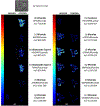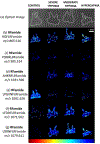A Simple and Effective Sample Preparation Strategy for MALDI-MS Imaging of Neuropeptide Changes in the Crustacean Brain Due to Hypoxia and Hypercapnia Stress
- PMID: 32150406
- PMCID: PMC7467133
- DOI: 10.1021/jasms.9b00107
A Simple and Effective Sample Preparation Strategy for MALDI-MS Imaging of Neuropeptide Changes in the Crustacean Brain Due to Hypoxia and Hypercapnia Stress
Abstract
Matrix-assisted laser desorption/ionization (MALDI)-MS imaging has been utilized to image a variety of biomolecules, including neuropeptides. Washing a tissue section is an effective way to eliminate interfering background and improve detection of low concentration target analyte molecules; however, many previous methods have not been tested for neuropeptide analysis via MALDI-MS imaging. Using crustaceans as a neurological model organism, we developed a new, simple washing procedure and applied this method to characterize neuropeptide changes due to hypoxia stress. With a 10 s 50:50 EtOH:H2O wash, neuropeptide coverage was improved by 1.15-fold, while normalized signal intensities were increased by 5.28-fold. Specifically, hypoxia and hypercapnia stress conditions were investigated due to their environmental relevance to marine invertebrates. Many neuropeptides, including RFamides, pyrokinin, and cardioactive peptides, showed distinct up- and down-regulation for specific neuropeptide isoforms. Since crustacean neuropeptides are homologous to those found in humans, results from these studies can be applied to understand potential roles of neuropeptides involved in medical hypoxia and hypercapnia.
Conflict of interest statement
Conflict of Interest
The authors declare no competing financial interest.
Figures




References
-
- Caprioli RM; Farmer TB; Gile J, Molecular imaging of biological samples: Localization of peptides and proteins using MALDI-TOF MS. Analytical Chemistry 1997, 69 (23), 4751–4760. - PubMed
-
- Heijs B; Holst S; Briaire-de Bruijn IH; van Pelt GW; de Ru AH; van Veelen PA; Drake RR; Mehta AS; Mesker WE; Tollenaar RA; Bovee J; Wuhrer M; McDonnell LA, Multimodal Mass Spectrometry Imaging of N-Glycans and Proteins from the Same Tissue Section. Analytical Chemistry 2016, 88 (15), 7745–7753. - PubMed
-
- Barre FPY; Flinders B; Garcia JP; Jansen I; Huizing LRS; Porta T; Creemers LB; Heeren RMA; Cillero-Pastor B, Derivatization Strategies for the Detection of Triamcinolone Acetonide in Cartilage by Using Matrix-Assisted Laser Desorption/Ionization Mass Spectrometry Imaging. Analytical Chemistry 2016, 88 (24), 12051–12059. - PubMed
-
- Angerer TB; Magnusson Y; Landberg G; Fletcher JS, Lipid Heterogeneity Resulting from Fatty Acid Processing in the Human Breast Cancer Microenvironment Identified by GCIB-ToF-SIMS Imaging. Analytical Chemistry 2016, 88 (23), 11946–11954. - PubMed
MeSH terms
Substances
Grants and funding
LinkOut - more resources
Full Text Sources

